Abstract
An overall hypothesis for benzene-induced leukemia is proposed. Key components of the hypothesis include a) activation of benzene in the liver to phenolic metabolites; b) transport of these metabolites to the bone marrow and conversion to semiquinone radicals and quinones via peroxidase enzymes; c) generation of active oxygen species via redox cycling; d) damage to tubulin, histone proteins, topoisomerase II, other DNA associated proteins, and DNA itself; and e) consequent damage including DNA strand breakage, mitotic recombination, chromosome translocations, and aneuploidy. If these effects take place in stem or early progenitor cells a leukemic clone with selective advantage to grow may arise, as a result of protooncogene activation, gene fusion, and suppressor gene inactivation. Epigenetic effects of benzene metabolites on the bone marrow stroma, and perhaps the stem cell itself, may then foster development and survival of the leukemic clone. Evidence for this hypothesis is mounting with the recent demonstration that benzene induces gene-duplicating mutations in human bone marrow and chromosome-specific aneuploidy and translocations in peripheral blood cells. If this hypothesis is correct, it also potentially implicates phenolic and quinonoid compounds in the induction of "spontaneous" leukemia in man.
Full text
PDF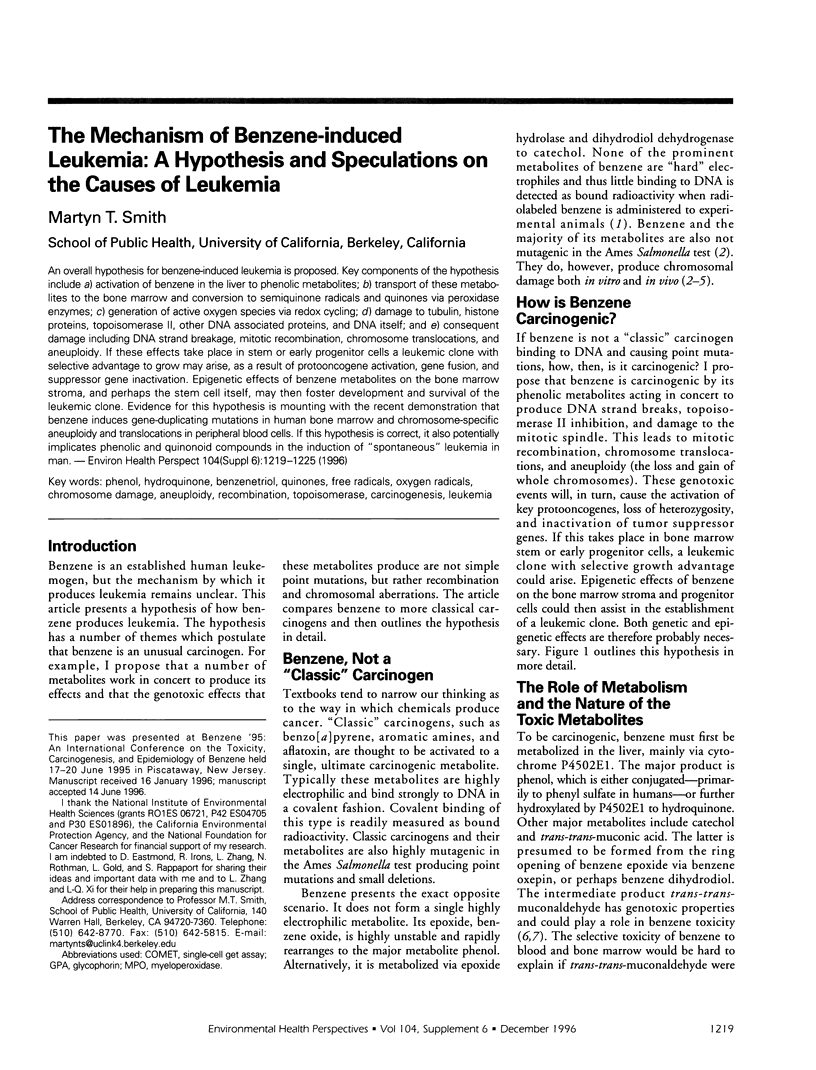
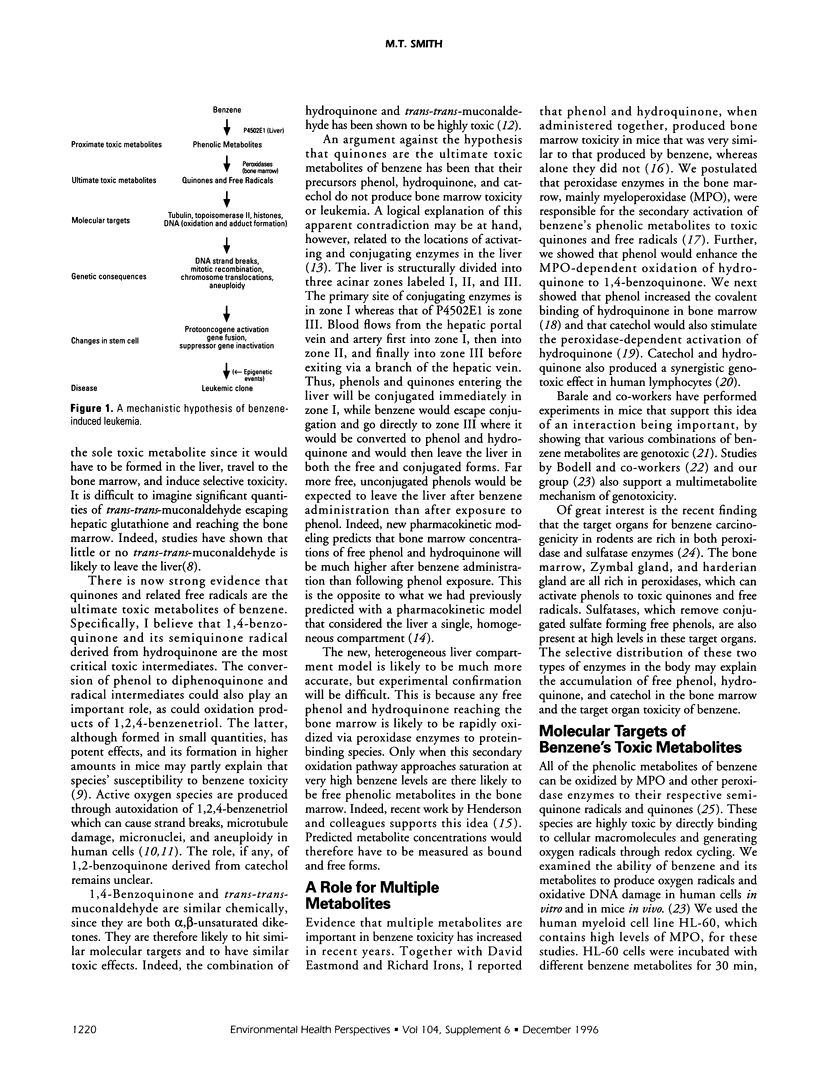
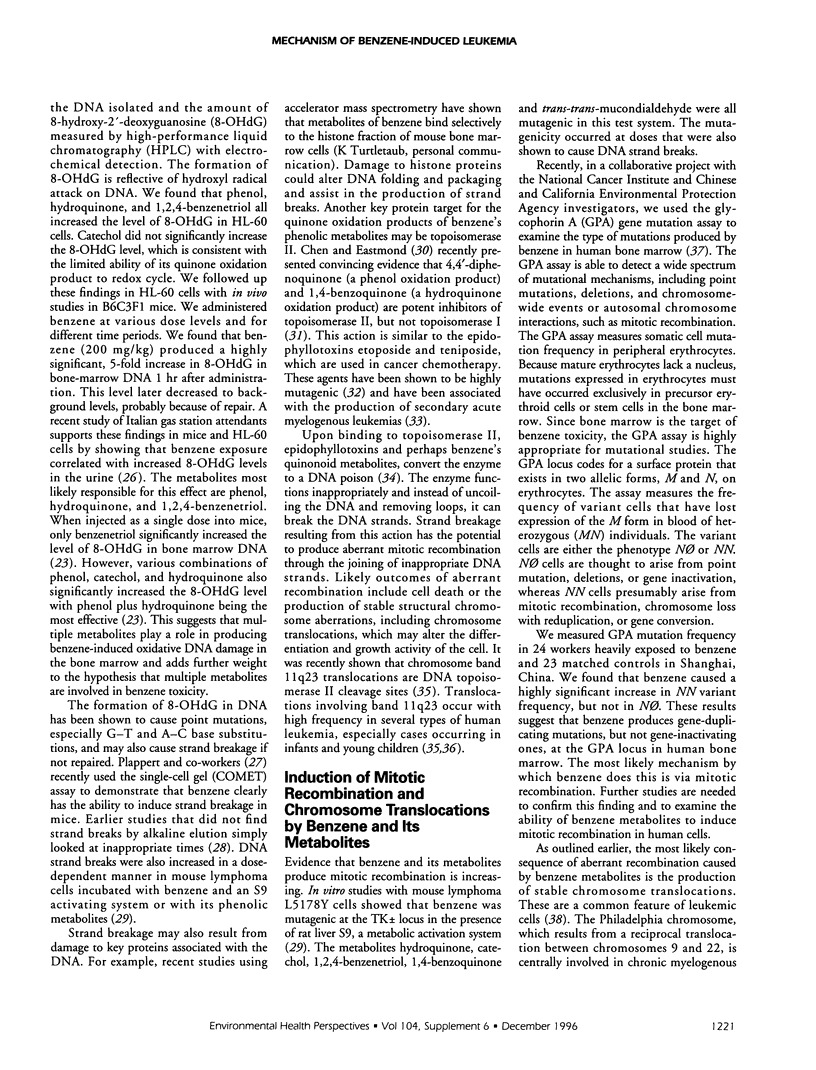
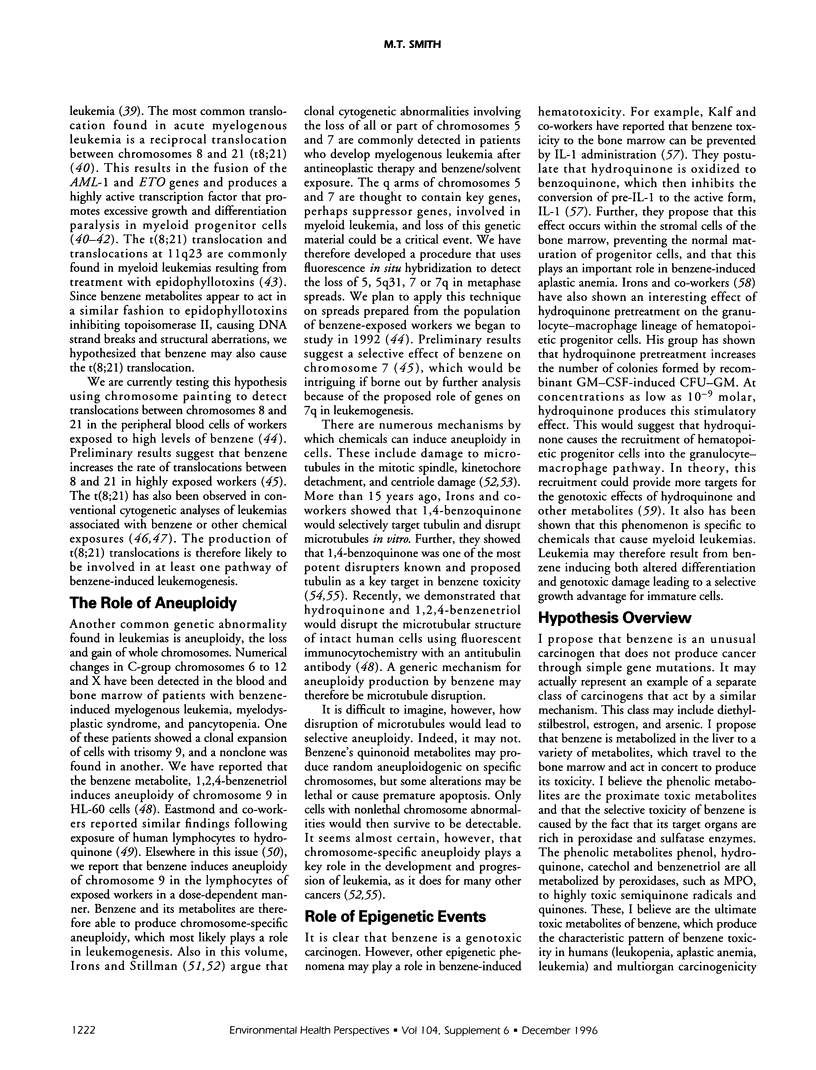
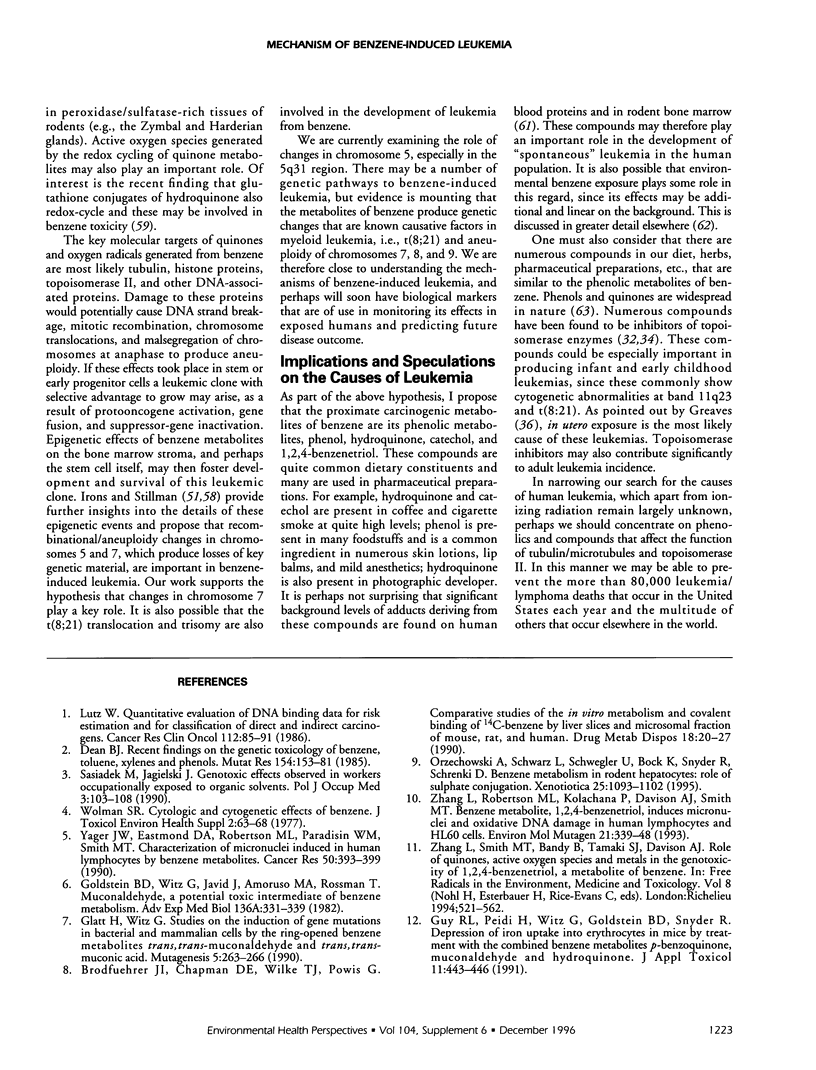
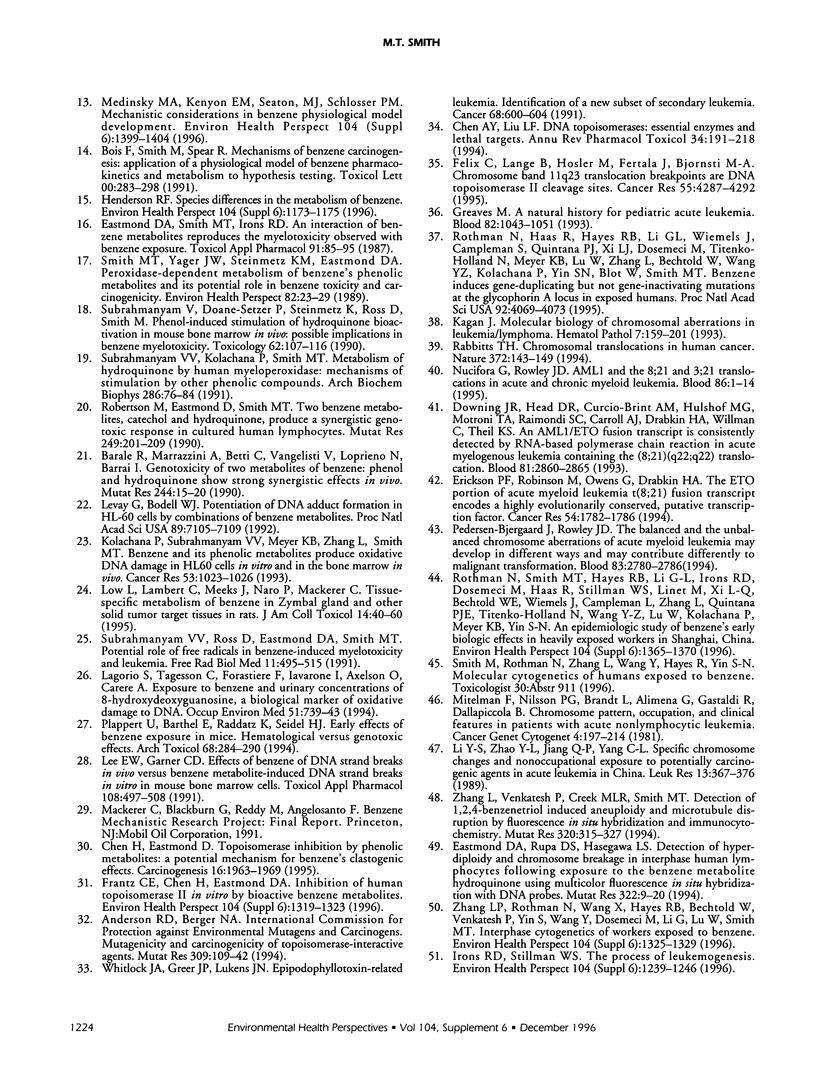
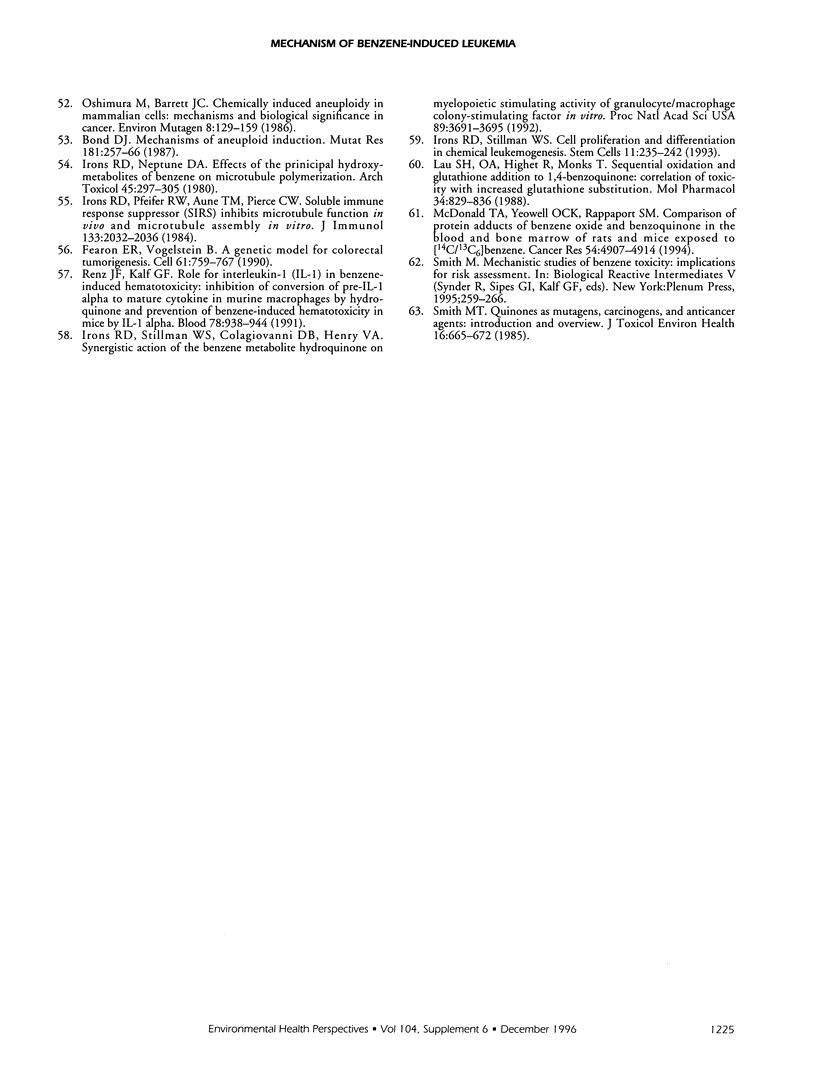
Selected References
These references are in PubMed. This may not be the complete list of references from this article.
- Anderson R. D., Berger N. A. International Commission for Protection Against Environmental Mutagens and Carcinogens. Mutagenicity and carcinogenicity of topoisomerase-interactive agents. Mutat Res. 1994 Aug 1;309(1):109–142. doi: 10.1016/0027-5107(94)90048-5. [DOI] [PubMed] [Google Scholar]
- Barale R., Marrazzini A., Betti C., Vangelisti V., Loprieno N., Barrai I. Genotoxicity of two metabolites of benzene: phenol and hydroquinone show strong synergistic effects in vivo. Mutat Res. 1990 May;244(1):15–20. doi: 10.1016/0165-7992(90)90101-o. [DOI] [PubMed] [Google Scholar]
- Bois F. Y., Smith M. T., Spear R. C. Mechanisms of benzene carcinogenesis: application of a physiological model of benzene pharmacokinetics and metabolism. Toxicol Lett. 1991 May;56(3):283–298. doi: 10.1016/0378-4274(91)90157-2. [DOI] [PubMed] [Google Scholar]
- Bond D. J. Mechanisms of aneuploid induction. Mutat Res. 1987 Dec;181(2):257–266. doi: 10.1016/0027-5107(87)90103-5. [DOI] [PubMed] [Google Scholar]
- Brodfuehrer J. I., Chapman D. E., Wilke T. J., Powis G. Comparative studies of the in vitro metabolism and covalent binding of 14C-benzene by liver slices and microsomal fraction of mouse, rat, and human. Drug Metab Dispos. 1990 Jan-Feb;18(1):20–27. [PubMed] [Google Scholar]
- Chen A. Y., Liu L. F. DNA topoisomerases: essential enzymes and lethal targets. Annu Rev Pharmacol Toxicol. 1994;34:191–218. doi: 10.1146/annurev.pa.34.040194.001203. [DOI] [PubMed] [Google Scholar]
- Chen H., Eastmond D. A. Synergistic increase in chromosomal breakage within the euchromatin induced by an interaction of the benzene metabolites phenol and hydroquinone in mice. Carcinogenesis. 1995 Aug;16(8):1963–1969. doi: 10.1093/carcin/16.8.1963. [DOI] [PubMed] [Google Scholar]
- Dean B. J. Recent findings on the genetic toxicology of benzene, toluene, xylenes and phenols. Mutat Res. 1985 Nov;154(3):153–181. doi: 10.1016/0165-1110(85)90016-8. [DOI] [PubMed] [Google Scholar]
- Downing J. R., Head D. R., Curcio-Brint A. M., Hulshof M. G., Motroni T. A., Raimondi S. C., Carroll A. J., Drabkin H. A., Willman C., Theil K. S. An AML1/ETO fusion transcript is consistently detected by RNA-based polymerase chain reaction in acute myelogenous leukemia containing the (8;21)(q22;q22) translocation. Blood. 1993 Jun 1;81(11):2860–2865. [PubMed] [Google Scholar]
- Eastmond D. A., Rupa D. S., Hasegawa L. S. Detection of hyperdiploidy and chromosome breakage in interphase human lymphocytes following exposure to the benzene metabolite hydroquinone using multicolor fluorescence in situ hybridization with DNA probes. Mutat Res. 1994 Jul;322(1):9–20. doi: 10.1016/0165-1218(94)90028-0. [DOI] [PubMed] [Google Scholar]
- Eastmond D. A., Smith M. T., Irons R. D. An interaction of benzene metabolites reproduces the myelotoxicity observed with benzene exposure. Toxicol Appl Pharmacol. 1987 Oct;91(1):85–95. doi: 10.1016/0041-008x(87)90196-7. [DOI] [PubMed] [Google Scholar]
- Erickson P. F., Robinson M., Owens G., Drabkin H. A. The ETO portion of acute myeloid leukemia t(8;21) fusion transcript encodes a highly evolutionarily conserved, putative transcription factor. Cancer Res. 1994 Apr 1;54(7):1782–1786. [PubMed] [Google Scholar]
- Fearon E. R., Vogelstein B. A genetic model for colorectal tumorigenesis. Cell. 1990 Jun 1;61(5):759–767. doi: 10.1016/0092-8674(90)90186-i. [DOI] [PubMed] [Google Scholar]
- Felix C. A., Lange B. J., Hosler M. R., Fertala J., Bjornsti M. A. Chromosome band 11q23 translocation breakpoints are DNA topoisomerase II cleavage sites. Cancer Res. 1995 Oct 1;55(19):4287–4292. [PubMed] [Google Scholar]
- Frantz C. E., Chen H., Eastmond D. A. Inhibition of human topoisomerase II in vitro by bioactive benzene metabolites. Environ Health Perspect. 1996 Dec;104 (Suppl 6):1319–1323. doi: 10.1289/ehp.961041319. [DOI] [PMC free article] [PubMed] [Google Scholar]
- Glatt H., Witz G. Studies on the induction of gene mutations in bacterial and mammalian cells by the ring-opened benzene metabolites trans,trans-muconaldehyde and trans,trans-muconic acid. Mutagenesis. 1990 May;5(3):263–266. doi: 10.1093/mutage/5.3.263. [DOI] [PubMed] [Google Scholar]
- Greaves M. A natural history for pediatric acute leukemia. Blood. 1993 Aug 15;82(4):1043–1051. [PubMed] [Google Scholar]
- Guy R. L., Hu P., Witz G., Goldstein B. D., Snyder R. Depression of iron uptake into erythrocytes in mice by treatment with the combined benzene metabolites p-benzoquinone, muconaldehyde and hydroquinone. J Appl Toxicol. 1991 Dec;11(6):443–446. doi: 10.1002/jat.2550110611. [DOI] [PubMed] [Google Scholar]
- Henderson R. F. Species differences in the metabolism of benzene. Environ Health Perspect. 1996 Dec;104 (Suppl 6):1173–1175. doi: 10.1289/ehp.961041173. [DOI] [PMC free article] [PubMed] [Google Scholar]
- Irons R. D., Neptun D. A. Effects of the principal hydroxy-metabolites of benzene on microtubule polymerization. Arch Toxicol. 1980 Oct;45(4):297–305. doi: 10.1007/BF00293810. [DOI] [PubMed] [Google Scholar]
- Irons R. D., Pfeifer R. W., Aune T. M., Pierce C. W. Soluble immune response suppressor (SIRS) inhibits microtubule function in vivo and microtubule assembly in vitro. J Immunol. 1984 Oct;133(4):2032–2036. [PubMed] [Google Scholar]
- Irons R. D., Stillman W. S. Cell proliferation and differentiation in chemical leukemogenesis. Stem Cells. 1993 May;11(3):235–242. doi: 10.1002/stem.5530110311. [DOI] [PubMed] [Google Scholar]
- Irons R. D., Stillman W. S., Colagiovanni D. B., Henry V. A. Synergistic action of the benzene metabolite hydroquinone on myelopoietic stimulating activity of granulocyte/macrophage colony-stimulating factor in vitro. Proc Natl Acad Sci U S A. 1992 May 1;89(9):3691–3695. doi: 10.1073/pnas.89.9.3691. [DOI] [PMC free article] [PubMed] [Google Scholar]
- Irons R. D., Stillman W. S. The process of leukemogenesis. Environ Health Perspect. 1996 Dec;104 (Suppl 6):1239–1246. doi: 10.1289/ehp.961041239. [DOI] [PMC free article] [PubMed] [Google Scholar]
- Kagan J. Molecular biology of chromosomal aberrations in leukemia/lymphoma. Hematol Pathol. 1993;7(3):159–201. [PubMed] [Google Scholar]
- Kolachana P., Subrahmanyam V. V., Meyer K. B., Zhang L., Smith M. T. Benzene and its phenolic metabolites produce oxidative DNA damage in HL60 cells in vitro and in the bone marrow in vivo. Cancer Res. 1993 Mar 1;53(5):1023–1026. [PubMed] [Google Scholar]
- Lagorio S., Tagesson C., Forastiere F., Iavarone I., Axelson O., Carere A. Exposure to benzene and urinary concentrations of 8-hydroxydeoxyguanosine, a biological marker of oxidative damage to DNA. Occup Environ Med. 1994 Nov;51(11):739–743. doi: 10.1136/oem.51.11.739. [DOI] [PMC free article] [PubMed] [Google Scholar]
- Lau S. S., Hill B. A., Highet R. J., Monks T. J. Sequential oxidation and glutathione addition to 1,4-benzoquinone: correlation of toxicity with increased glutathione substitution. Mol Pharmacol. 1988 Dec;34(6):829–836. [PubMed] [Google Scholar]
- Lee E. W., Garner C. D. Effects of benzene on DNA strand breaks in vivo versus benzene metabolite-induced DNA strand breaks in vitro in mouse bone marrow cells. Toxicol Appl Pharmacol. 1991 May;108(3):497–508. doi: 10.1016/0041-008x(91)90096-w. [DOI] [PubMed] [Google Scholar]
- Li Y. S., Zhao Y. L., Jiang Q. P., Yang C. L. Specific chromosome changes and nonoccupational exposure to potentially carcinogenic agents in acute leukemia in China. Leuk Res. 1989;13(5):367–376. doi: 10.1016/0145-2126(89)90076-3. [DOI] [PubMed] [Google Scholar]
- Lutz W. K. Quantitative evaluation of DNA binding data for risk estimation and for classification of direct and indirect carcinogens. J Cancer Res Clin Oncol. 1986;112(2):85–91. doi: 10.1007/BF00404387. [DOI] [PubMed] [Google Scholar]
- Lévay G., Bodell W. J. Potentiation of DNA adduct formation in HL-60 cells by combinations of benzene metabolites. Proc Natl Acad Sci U S A. 1992 Aug 1;89(15):7105–7109. doi: 10.1073/pnas.89.15.7105. [DOI] [PMC free article] [PubMed] [Google Scholar]
- McDonald T. A., Yeowell-O'Connell K., Rappaport S. M. Comparison of protein adducts of benzene oxide and benzoquinone in the blood and bone marrow of rats and mice exposed to [14C/13C6]benzene. Cancer Res. 1994 Sep 15;54(18):4907–4914. [PubMed] [Google Scholar]
- Medinsky M. A., Kenyon E. M., Seaton M. J., Schlosser P. M. Mechanistic considerations in benzene physiological model development. Environ Health Perspect. 1996 Dec;104 (Suppl 6):1399–1404. doi: 10.1289/ehp.961041399. [DOI] [PMC free article] [PubMed] [Google Scholar]
- Mitelman F., Nilsson P. G., Brandt L., Alimena G., Gastaldi R., Dallapiccola B. Chromosome pattern, occupation, and clinical features in patients with acute nonlymphocytic leukemia. Cancer Genet Cytogenet. 1981 Nov;4(3):197–214. doi: 10.1016/0165-4608(81)90014-5. [DOI] [PubMed] [Google Scholar]
- Nucifora G., Rowley J. D. AML1 and the 8;21 and 3;21 translocations in acute and chronic myeloid leukemia. Blood. 1995 Jul 1;86(1):1–14. [PubMed] [Google Scholar]
- Orzechowski A., Schwarz L. R., Schwegler U., Bock K. W., Snyder R., Schrenk D. Benzene metabolism in rodent hepatocytes: role of sulphate conjugation. Xenobiotica. 1995 Nov;25(10):1093–1102. doi: 10.3109/00498259509061909. [DOI] [PubMed] [Google Scholar]
- Oshimura M., Barrett J. C. Chemically induced aneuploidy in mammalian cells: mechanisms and biological significance in cancer. Environ Mutagen. 1986;8(1):129–159. doi: 10.1002/em.2860080112. [DOI] [PubMed] [Google Scholar]
- Pedersen-Bjergaard J., Rowley J. D. The balanced and the unbalanced chromosome aberrations of acute myeloid leukemia may develop in different ways and may contribute differently to malignant transformation. Blood. 1994 May 15;83(10):2780–2786. [PubMed] [Google Scholar]
- Plappert U., Barthel E., Raddatz K., Seidel H. J. Early effects of benzene exposure in mice. Hematological versus genotoxic effects. Arch Toxicol. 1994;68(5):284–290. doi: 10.1007/s002040050070. [DOI] [PubMed] [Google Scholar]
- Rabbitts T. H. Chromosomal translocations in human cancer. Nature. 1994 Nov 10;372(6502):143–149. doi: 10.1038/372143a0. [DOI] [PubMed] [Google Scholar]
- Renz J. F., Kalf G. F. Role for interleukin-1 (IL-1) in benzene-induced hematotoxicity: inhibition of conversion of pre-IL-1 alpha to mature cytokine in murine macrophages by hydroquinone and prevention of benzene-induced hematotoxicity in mice by IL-1 alpha. Blood. 1991 Aug 15;78(4):938–944. [PubMed] [Google Scholar]
- Robertson M. L., Eastmond D. A., Smith M. T. Two benzene metabolites, catechol and hydroquinone, produce a synergistic induction of micronuclei and toxicity in cultured human lymphocytes. Mutat Res. 1991 Jul;249(1):201–209. doi: 10.1016/0027-5107(91)90147-g. [DOI] [PubMed] [Google Scholar]
- Rothman N., Haas R., Hayes R. B., Li G. L., Wiemels J., Campleman S., Quintana P. J., Xi L. J., Dosemeci M., Titenko-Holland N. Benzene induces gene-duplicating but not gene-inactivating mutations at the glycophorin A locus in exposed humans. Proc Natl Acad Sci U S A. 1995 Apr 25;92(9):4069–4073. doi: 10.1073/pnas.92.9.4069. [DOI] [PMC free article] [PubMed] [Google Scholar]
- Rothman N., Smith M. T., Hayes R. B., Li G. L., Irons R. D., Dosemeci M., Haas R., Stillman W. S., Linet M., Xi L. Q. An epidemiologic study of early biologic effects of benzene in Chinese workers. Environ Health Perspect. 1996 Dec;104 (Suppl 6):1365–1370. doi: 10.1289/ehp.961041365. [DOI] [PMC free article] [PubMed] [Google Scholar]
- Sasiadek M., Jagielski J. Genotoxic effects observed in workers occupationally exposed to organic solvents. Pol J Occup Med. 1990;3(1):103–108. [PubMed] [Google Scholar]
- Smith M. T. Quinones as mutagens, carcinogens, and anticancer agents: introduction and overview. J Toxicol Environ Health. 1985;16(5):665–672. doi: 10.1080/15287398509530776. [DOI] [PubMed] [Google Scholar]
- Smith M. T., Yager J. W., Steinmetz K. L., Eastmond D. A. Peroxidase-dependent metabolism of benzene's phenolic metabolites and its potential role in benzene toxicity and carcinogenicity. Environ Health Perspect. 1989 Jul;82:23–29. doi: 10.1289/ehp.898223. [DOI] [PMC free article] [PubMed] [Google Scholar]
- Subrahmanyam V. V., Doane-Setzer P., Steinmetz K. L., Ross D., Smith M. T. Phenol-induced stimulation of hydroquinone bioactivation in mouse bone marrow in vivo: possible implications in benzene myelotoxicity. Toxicology. 1990 May 14;62(1):107–116. doi: 10.1016/0300-483x(90)90035-f. [DOI] [PubMed] [Google Scholar]
- Subrahmanyam V. V., Kolachana P., Smith M. T. Metabolism of hydroquinone by human myeloperoxidase: mechanisms of stimulation by other phenolic compounds. Arch Biochem Biophys. 1991 Apr;286(1):76–84. doi: 10.1016/0003-9861(91)90010-g. [DOI] [PubMed] [Google Scholar]
- Subrahmanyam V. V., Ross D., Eastmond D. A., Smith M. T. Potential role of free radicals in benzene-induced myelotoxicity and leukemia. Free Radic Biol Med. 1991;11(5):495–515. doi: 10.1016/0891-5849(91)90063-9. [DOI] [PubMed] [Google Scholar]
- Whitlock J. A., Greer J. P., Lukens J. N. Epipodophyllotoxin-related leukemia. Identification of a new subset of secondary leukemia. Cancer. 1991 Aug 1;68(3):600–604. doi: 10.1002/1097-0142(19910801)68:3<600::aid-cncr2820680326>3.0.co;2-f. [DOI] [PubMed] [Google Scholar]
- Wolman S. R. Cytologic and cytogenetic effects of benzene. J Toxicol Environ Health Suppl. 1977;2:63–68. [PubMed] [Google Scholar]
- Yager J. W., Eastmond D. A., Robertson M. L., Paradisin W. M., Smith M. T. Characterization of micronuclei induced in human lymphocytes by benzene metabolites. Cancer Res. 1990 Jan 15;50(2):393–399. [PubMed] [Google Scholar]
- Zhang L., Robertson M. L., Kolachana P., Davison A. J., Smith M. T. Benzene metabolite, 1,2,4-benzenetriol, induces micronuclei and oxidative DNA damage in human lymphocytes and HL60 cells. Environ Mol Mutagen. 1993;21(4):339–348. doi: 10.1002/em.2850210405. [DOI] [PubMed] [Google Scholar]
- Zhang L., Rothman N., Wang Y., Hayes R. B., Bechtold W., Venkatesh P., Yin S., Wang Y., Dosemeci M., Li G. Interphase cytogenetics of workers exposed to benzene. Environ Health Perspect. 1996 Dec;104 (Suppl 6):1325–1329. doi: 10.1289/ehp.961041325. [DOI] [PMC free article] [PubMed] [Google Scholar]
- Zhang L., Venkatesh P., Creek M. L., Smith M. T. Detection of 1,2,4-benzenetriol induced aneuploidy and microtubule disruption by fluorescence in situ hybridization and immunocytochemistry. Mutat Res. 1994 Mar;320(4):315–327. doi: 10.1016/0165-1218(94)90084-1. [DOI] [PubMed] [Google Scholar]


